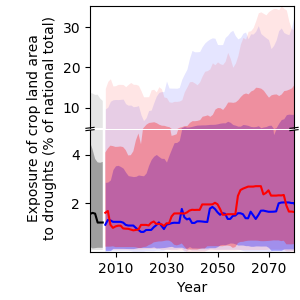Mali: Agriculture
Smallholder farmers in Mali are increasingly challenged by the uncertainty and variability of weather that climate change causes [16], [17]. Since crops are predominantly rainfed, crop yields depend on water availability from precipitation and are prone to drought. However, the length and intensity of the rainy season is becoming increasingly unpredictable and the use of irrigation facilities remains limited despite Mali’s considerable irrigation potential of approximately 566 000 ha (1.4 % of the national crop land) [21], [22]. Currently, only 30 % of that potential is irrigated [6]. Especially in central and northern Mali, soils are sandy and poor in nutrients, which complicates irrigation and crop production.
Crop land exposure to drought

Currently, the high uncertainty of projections regarding water availability (Figure 9) translates into high uncertainty of drought projections (Figure 10). According to the median over all models employed for this analysis, the national crop land area exposed to at least one drought per year will hardly change in response to global warming. However, there are models that project a strong increase in drought exposure. Under RCP6.0, the likely range of drought exposure of the national crop land area per year widens from 0.2–4.5 % in 2000 to 0.03–15.0 % in 2080. The very likely range widens from 0.1–13.6 % in 2000 to 0.02–29.4 % in 2080. This means that some models project up to a threefold increase in drought exposure over this time period, while others project no change.
Crop yield projections

In terms of yield projections, model results indicate a negative trend for maize, millet, sorghum and groundnuts (Figure 11). While maize is sensitive to hot temperatures above 35 °C, millet, sorghum and groundnuts tolerate hot temperatures and dry periods better [23]. Compared to the year 2000, yields are projected to decline by 13 % for maize, 12 % for millet and sorghum, and 7 % for groundnuts by 2080 under RCP6.0. Under RCP2.6, yields are projected to decline by 8 % for maize, 8 % for millet and sorghum, and 14 % for groundnuts. Yields of rice, on the contrary, are projected to gain from climate change. Under RCP6.0, yields are projected to increase by 29 % by 2080 relative to the year 2000. A possible explanation for the positive results under RCP6.0 is that rice is a socalled C3 plant, which follows a different metabolic pathway than maize, millet and sorghum (C4 plants), and benefits more from the CO2 fertilisation effect under higher concentration pathways. Yields of cow peas are projected to decrease under RCP2.6 and remain unchanged under RCP6.0. The decrease under RCP2.6 can be explained by non-temperature related parameters such as changes in precipitation, while the trend under RCP6.0 can be explained by the CO2 fertilisation effect. This explanation also applies to the projected stronger decrease in yields of groundnuts under RCP2.6.
Overall, adaptation strategies such as switching to improved varieties in climate change sensitive crops need to be considered, yet should be carefully weighed against adverse outcomes, such as a resulting decline of agro-biodiversity and loss of local crop types.
References
[6] FAO, “Country Fact Sheet on Food and Agriculture Policy Trends: Mali,” Rome, Italy, 2017.
[16] B. Traore, M. Corbeels, M. T. van Wijk, M. C. Rufino, and K. E. Giller, “Effects of Climate Variability and Climate Change on Crop Production in Southern Mali,” Eur. J. Agron., vol. 49, pp. 115–125, 2013.
[17] B. Sultan, P. Roudier, P. Quirion, A. Alhassane, B. Muller, M. Dingkuhn, P. Ciais, M. Guimberteau, S. Traore, and C. Baron, “Assessing Climate Change Impacts on Sorghum and Millet Yields in the Sudanian and Sahelian Savannas of West Africa,” Environ. Res. Lett., vol. 8, pp. 1–9, 2013.
[21] AQUASTAT, “Irrigation and drainage development.” Online available: http://www.fao.org/nr/water/aquastat/data/query/results.html [Accessed: 06-Jul-2020].
[22] FAO, “Mali Country Profile,” 2016. Online available: http://www. fao.org/countryprofiles/index/en/?iso3=MLI [Accessed: 21-Feb-2020].
[23] USAID, “Climate Risk in Food for Peace Geographies: Kenya,” Washington, D.C., 2019.


